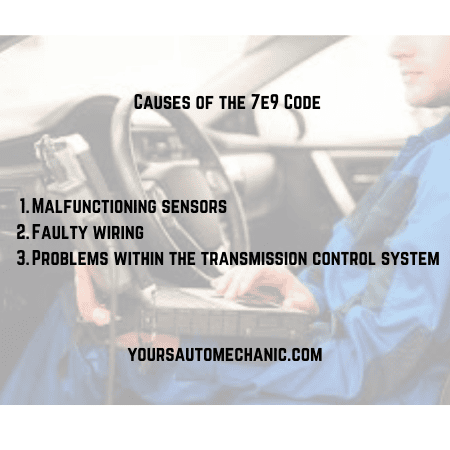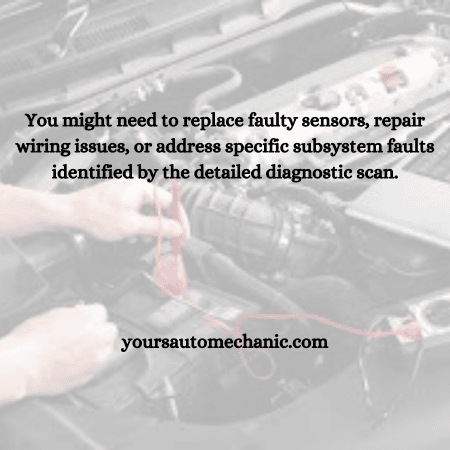Each engine code corresponds to a specific fault in the vehicle. These codes can be triggered by a range of issues, from minor sensor malfunctions to significant engine problems. This article will cover 7e9 engine code, So keep on reading…
What Is 7e9 Engine Code?
The 7e9 code is not a standard OBD-II trouble code but rather a request for more information from the Engine Control Module (ECM). It essentially asks you to select a subsystem for a more detailed diagnostic. Think of it as your car saying, “I need to tell you something, but you’ll have to dig a bit deeper.”
When encountering “code 7e9,” you should look for other specific trouble codes. These codes will usually be in the format Pxxxx, Bxxxx, Cxxxx, or Uxxxx, where the x’s are numbers. These codes give you detailed information about what might be wrong with the vehicle.
You May Find Helpful: 7E8 Engine Code – Symptoms | Causes | Troubleshooting

symptoms of 7e9 engine code
The “7e9 engine code” itself is not a direct engine code but an indication to check the Transmission Control Module (TCM) for more specific Diagnostic Trouble Codes (DTCs). However, if your vehicle is prompting you to check the TCM, there might be certain symptoms you can look for that indicate issues related to the transmission. Here are some common symptoms that might trigger such a notification:
Transmission Slipping: The transmission may slip in and out of gear while driving, causing a noticeable drop in power.
Harsh or Delayed Shifting: Shifts between gears might feel rough or take longer than usual, especially noticeable during acceleration.
Unusual Noises: You might hear grinding, whining, or clunking noises from the transmission when shifting gears.
Check Engine Light: The check engine light on your dashboard might be illuminated or flashing, indicating a problem that needs attention.
Poor Acceleration: The vehicle might struggle to accelerate properly, even when pressing the gas pedal.
Stalling or Hesitation: The engine might stall or hesitate, particularly when shifting from park to drive or during gear changes.
Transmission Overheating: The transmission may overheat, often indicated by a warning light or unusual smells, such as burning fluid.
Reduced Fuel Efficiency: You might notice a decrease in fuel efficiency, as transmission issues can affect the overall performance of the vehicle.
If you experience any of these symptoms, it’s a good idea to use an OBD-II scanner to check for specific DTCs stored in the TCM. These codes will give you more detailed information about the exact issue with your vehicle’s transmission system.
why does this code appear? – Causes Of 7e9 code
Here’s why this code might appear:
Transmission Issues: Problems within the transmission system, such as slipping gears, harsh shifting, or unusual noises, can trigger the TCM to store trouble codes.
Sensor Malfunctions: Faulty sensors related to the transmission, such as speed sensors or pressure sensors, can cause the TCM to flag errors.
Electrical Problems: Issues with the wiring or connectors that link the transmission to the TCM can lead to communication errors, prompting the TCM to generate codes.
Fluid Problems: Low, dirty, or overheating transmission fluid can affect the performance of the transmission, causing the TCM to detect and report issues.
Mechanical Failures: Internal mechanical problems within the transmission, such as worn gears or a failing torque converter, can result in the TCM identifying malfunctions.
Software Issues: Problems with the software or firmware of the TCM, such as outdated or corrupted software, can cause it to store error codes.
Environmental Factors: Extreme temperatures or other environmental conditions can impact the transmission and related components, leading to TCM detecting anomalies.

how to fix 7e9 engine code
To fix issues indicated by the “7e9” engine code, you need to follow a systematic approach to diagnose and resolve the underlying problems in the Transmission Control Module (TCM) or transmission system. Here’s a step-by-step guide:
Scan for Specific Trouble Codes:
Use an OBD-II scanner to read the specific Diagnostic Trouble Codes (DTCs) stored in the TCM. The “7e9” code itself is not specific; it directs you to check for more detailed codes like P0700 (general transmission fault), P0730 (incorrect gear ratio), or others related to the transmission.
Interpret the Codes:
Once you have the specific DTCs, look up their meanings. These codes will give you precise information about what might be wrong with the transmission system.
Inspect Transmission Fluid:
Check the transmission fluid level and condition. Low, dirty, or burnt transmission fluid can cause many transmission problems. If needed, replace or top up the transmission fluid with the type specified by the vehicle manufacturer.
Check Transmission Sensors and Wiring:
Inspect sensors related to the transmission, such as the speed sensors, pressure sensors, and their wiring. Look for signs of damage, wear, or loose connections. Replace or repair any faulty components.
Examine the Transmission Control Module (TCM):
Ensure the TCM is functioning correctly. Sometimes, the TCM itself may need a software update or, in rare cases, replacement. Check for any recall notices or technical service bulletins (TSBs) related to the TCM.
Test Drive and Monitor:
After addressing any identified issues, perform a test drive to see if the problems persist. Use the OBD-II scanner to monitor the transmission performance and ensure no new codes appear.
If you’re unable to identify or fix the issue yourself, it’s advisable to take your vehicle to a professional mechanic or transmission specialist. They have the tools and expertise to diagnose and repair complex transmission problems.
Further Readings
- How To Clear Engine Derate? Step By Step Guide
- Why Does My RPM Go Up And Down While Parked – 6 Main Causes
Common Fixes for Specific Issues:
1- Transmission Fluid Issues:
Replace or top up transmission fluid.
Flush the transmission if the fluid is contaminated.
2- Sensor Problems:
Replace faulty sensors.
Repair or replace damaged wiring or connectors.
3- Mechanical Failures:
Repair or replace worn gears, clutches, or other internal components.
Address issues with the torque converter.
4- Electrical or Software Issues:
Update or reflash the TCM software.
Replace the TCM if necessary.
By following these steps, you can systematically address the issues indicated by the “7e9” engine code and ensure your transmission system is functioning properly.
Must Read
- Code P0014 – Meaning | Symptoms | Causes | Solutions
- P1101 Chevy Cruze – Symptoms | Causes | Solution
- P0008 Code But Car Runs Fine – Its Causes & Potential Action
Conclusion
The 7e9 engine code might initially seem daunting, but understanding its implications and knowing how to respond can save you time, money, and stress. Regular maintenance and timely repairs are your best defense against unexpected engine codes. Remember, when in doubt, seek professional help to ensure your vehicle remains in top condition.
